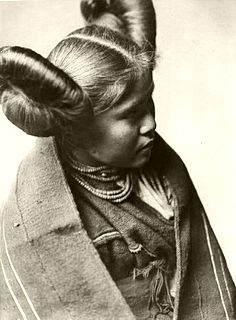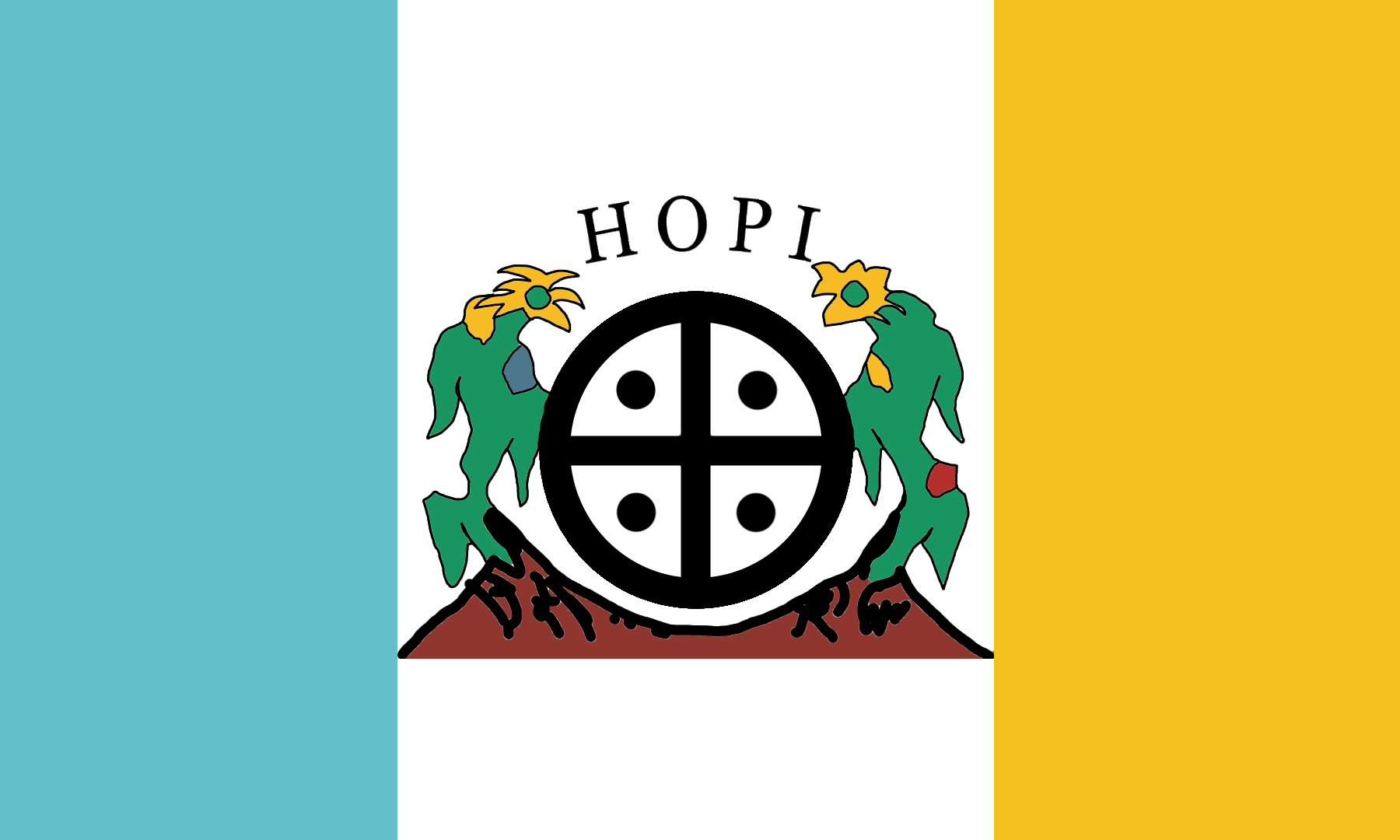
Mohave or Mojave (Mojave: 'Aha Makhav) are a Native American people indigenous to the Colorado River in the Mojave Desert. The Fort Mojave Indian Reservation includes territory within the borders of California, Arizona, and Nevada. The Colorado River Indian Reservation includes parts of California and Arizona and is shared by members of the Chemehuevi, Hopi, and Navajo peoples.
In Hopi mythology, Muyingwa is one of the kachinas responsible for the germination of seeds. Alosaka is another katchina responsible for growth of crops, and possibly an alternate name or alternate aspect of Muyingwa. As with other Katchinas Muyingwa and Alosaka are spirits represented by dolls and performed with masks at ceremonies. They are said to live in the San Francisco Peaks to the west of the Hopi Reservation.

Second Mesa is a census-designated place (CDP) in Navajo County, Arizona, on the Hopi Reservation, atop the 5,700-foot mesa. As of the 2010 census, the CDP population was 962, spread among three Hopi Indian villages, Musungnuvi, Supawlavi, and Songoopavi. The Hopi Cultural Center is on Second Mesa.

Lori Ann Piestewa was a United States Army soldier killed during the Iraq War. A member of the Quartermaster Corps, she died in the same Iraqi attack in which fellow soldiers Shoshana Johnson and Jessica Lynch were injured. A member of the Hopi tribe, Piestewa was the first Native American woman in history to die in combat while serving in the U.S. military and the first woman in the U.S. military killed in the Iraq War. Arizona's Piestewa Peak is named in her honor.

Native Americans have inhabited what is now Arizona for thousands of years. It remains a state with one of the largest percentages of Native Americans in the United States, and has the second largest total Native American population of any state. In addition, the majority of the Navajo Nation, the largest Native American reservation in the US, and the entire Tohono O'odham Nation, the second largest, are located in Arizona. Over a quarter of the area of the state is reservation land.

An Indian reservation is a legal designation for an area of land managed by a federally recognized Native American tribe under the U.S. Bureau of Indian Affairs rather than the state governments of the United States in which they are physically located. Each of the 326 Indian reservations in the United States is associated with a particular Native American nation. Not all of the country's 567 recognized tribes have a reservation—some tribes have more than one reservation, while some share reservations. In addition, because of past land allotments, leading to some sales to non–Native Americans, some reservations are severely fragmented, with each piece of tribal, individual, and privately held land being a separate enclave. This jumble of private and public real estate creates significant administrative, political, and legal difficulties.
Tewa is a Tanoan language spoken by Pueblo people, mostly in the Rio Grande valley in New Mexico north of Santa Fe, and in Arizona. It is also known as Tano, or (archaic) Tée-wah.

The Tewa are a linguistic group of Pueblo Native Americans who speak the Tewa language and share the Pueblo culture. Their homelands are on or near the Rio Grande in New Mexico north of Santa Fe. They comprise the following communities:
The Hopi-Tewa are a Tewa Pueblo group that resides on the eastern part of the Hopi Reservation on or near First Mesa in northeastern Arizona.

Northeast Arizona is a region of the U.S. state of Arizona commonly including Apache County and Navajo County. Some notable towns there are St. Johns, Eagar, Holbrook, Show Low, Winslow, Window Rock, Fort Defiance, Ganado, Chinle, and Kayenta.

Louis Tewanima, also spelled Lewis Tewanima, was an American two-time Olympic distance runner and silver medalist in the 10,000 meter run in 1912. He was a Hopi Indian and ran for the Carlisle Indian School where he was a teammate of Jim Thorpe. His silver medal in 1912 remained the best U.S. achievement in this event until another Native American, Billy Mills, won the gold medal in 1964. Tewanima also competed at the 1908 Olympics, where he finished in ninth place in the marathon.
KUYI 88.1 FM, is a Native American Public Radio station in Keams Canyon, Arizona. The station, founded in 2000, primarily features locally produced programming for the Hopi, Tewa, and Navajo Native American tribal residents, surrounding communities in Northern Arizona, the Four Corners areas and streaming worldwide. Other network programming is provided by Native Voice One. Top of the hour news updates from National Public Radio are aired Monday through Friday. Its musical programming is a mix of traditional Hopi and modern music.
Emory Sekaquaptewa was a Hopi leader and scholar from the Third Mesa village of Hotevilla. Known as the "First Hopi" or "First Indian," he is best known for his role in compiling the first dictionary of the Hopi language. He became Assistant Professor, Department of Anthropology, University of Arizona in 1972, and was Professor in its Bureau of Applied Research in Anthropology from 1990-2007.
Traditional gender roles among Native American and First Nations peoples tend to vary greatly by region and community. As with all Pre-Columbian era societies, historical traditions may or may not reflect contemporary attitudes. In many communities, these things are not discussed with outsiders.
Thomas Banyacya was a Hopi Native American traditional leader. In 1948, he was one of four Hopis who were named by elders to reveal Hopi traditional wisdom and teachings, including the Hopi prophecies for the future, to the general public, after the atomic bombings of Hiroshima and Nagasaki in Japan. Banyacya was a member of the Wolf, Fox, and Coyote clans.
Arizona, a state in the southwestern region of the United States of America, is known for its high population of Native Americans. Arizona has the third highest number of Native Americans of any state in the Union. Out of the entire US population of 2.9 million Native Americans, roughly 286,680 live in Arizona, representing 10% of the country's total Native American population. Only California and Oklahoma have more Native Americans than Arizona by number. Arizona also has the highest proportion of land allocated to Native American reservations, at 28%. Arizona has five of the twelve largest Indian reservations in the United States, including the largest, the Navajo Nation, and the third-largest, the Tohono O'odham Nation. Also, Arizona has the largest number of Native American language speakers in the United States.

The flag of the Hopi Nation is used by the Native American Hopi people of Arizona in the United States who live on the Hopi Reservation. The flag is a vertical tricolour of turquoise, white, and yellow, with the Hopi symbol in the middle. The flag is accompanied by a red fringe. The Hopi reservation is completely surrounded by the Navajo Nation.









